Top News
May 11, 2013 Ryota Shimabukuro of Ryukyu Shimpo reports from Washington D.C.
Maj. Gen. James Kessler, commander of the Marine Corps Installations Command, told a Senate hearing, “We will be at Futenma for probably the next 10 to 15 years.” On May 9, at a subcommittee meeting of the Senate Appropriations Committee, the Marine general commented on progress on the consolidation plan of U.S. forces in Okinawa. In April the governments of Japan and the United States announced in their bilateral agreement that they would return the facilities south of the Kadena in “fiscal 2022 or later.” However, Kessler suggested that they would be using Futenma until 2027. This is the first time that U.S. officials have publicly acknowledged that the return of Futenma could be delayed.
Maj. Gen. Kessler explained that the Japanese government has applied to the Okinawa Governor to reclaim land in the waters off the Henoko area of Nago as part of the relocation plan of Futenma. He predicted that it would take about one year to gain the necessary permission from the Okinawa Governor. In April the U.S. Department of Defense announced the budget for the 2014 fiscal year running from October 1, 2013, to September 30, 2014. It includes $5 million (about 500 million yen) for the cost of maintaining the base at Futenma. Kessler stated that it would be spent on the safety fence at Futenma Air Station. He said that ongoing support for the aging facilities at Futenma is needed to maintain a level of safety and operational capability until alternative facilities are completed. Kessler suggested that they need about 4.7 billion yen over the next three years.
(English translation by T&CT, Mark Ealey)
Go to Japanese
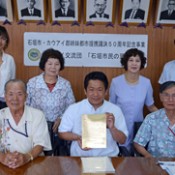
May 11, 2013 Ryukyu Shimpo
On May 10, in Kauai, Hawaii, Ishigaki City and Kauai County marked the 50th anniversary of their establishing a sister city relationship. The Ishigaki Municipal Government and Kauai Community College exchanged memorandums on international interaction to commemorate the anniversary.
The municipal government organized a citizens group called Wings of Ishigaki Citizens to carry out international exchange activities. The group members deepened exchange on a six-day visit to Kauai.
On May 1, 1963, the assembly of Kauai County unanimously passed a resolution to establish a sister-city relationship with Ishigaki City and sent this to the Ishigaki Municipal Government. The Ishigaki Municipal Assembly subsequently passed a resolution to establish a sister-city relationship with Kauai County on May 23 that same year.
However, exchange between both municipalities became stagnant through the years because the merger between Ishigaki City and former Ohama Town drastically reduced the number of personnel in the municipal government and assembly. As a result, there was no real exchange between two municipalities until 1999, when they resumed activities and now continue this in the form of exchange programs for junior high-school students.
At the ceremony, the delegation from Ishigaki presented a plate to the county of Kauai bearing the words of the 1963 resolution and promised to continue and to promote exchange. Ishigaki Mayor Yoshitaka Nakayama said, “I want to take this opportunity to promote new exchanges for both municipalities.”
(English translation by T&CT, Mark Ealey)
Go to Japanese
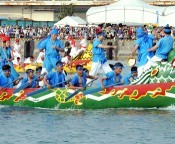
May 6, 2013 Ryukyu Shimpo
Many families and tourists visited Naha Port on May 5, the final day of the Naha Harii 2013 dragon boat race. It was slightly overcast in the morning, but the skies became clear in the afternoon and overall the three-day event was blessed with fine weather. The Naha team won the main race. People enjoyed the races, a variety of stage performances and fireworks.
According to the organizers, about 98,000 people visited the venue on the final day and the total number of participants was about 204,000 for the three days.
Three teams, including those from Naha, Tomari and Kume took part in the main race. With a time of 5 minutes 17.38 seconds, in a very tight finish Naha claimed victory ahead of Tomari, which was targeting a string of victories. The Naha team displayed great paddling skills. Its captain, Kai Odo, said, “Teamwork won the championship for us. This is the first time for us in four years, but we will win again next year.”
The winner of the Open Division A (men’s) was the U.S. Army’s team, the Torii Knights, and Okinawa City Fire Station team won Division B.
(English translation by T&CT, Mark Ealey)
Go to Japanese

Go To Video
May 5, 2013 Ryukyu Shimpo
On May 3, at the Ie Jima Auxiliary Airfield, the U.S. military conducted parachute training from MV-22 Osprey vertical take-off and landing transport aircraft. The training occurred 19 times over three consecutive days with a total of 15 aircraft flying to the airfield.
Up to eight soldiers jumped each time, with over 100 soldiers jumping.
The soldiers involved in the training appeared to board the aircraft at the U.S. Army Garrison Torii Station, from where Osprey took off and landed six times on May 3.
At around 10:00 a.m. that day two Osprey flew to Ie Jima Auxiliary Airfield and after circling toward the north seven soldiers parachuted to the ground at around 10:10 a.m. The Osprey changed altitude for each run, with seven or eight men jumping each time.
Five aircraft conducted the training a total of six times until 11:30a.m. that day.
It would appear that the military conducted this training until shortly after 12:00 p.m. Yells and cheers from the soldiers could occasionally be heard from within the base.
Flying in from over the sea, two Osprey aircraft landed on the touchdown area of the U.S. Army Garrison Torii Station next to Torii beach at 9:35 a.m. that day. The military conducted the training six times and it is confirmed that a total of nine aircraft flew to the station carrying a total of over 60 soldiers wearing backpacks.
When two Osprey took off at around 10:39 a.m., 88.8 decibels of aircraft noise were recorded along the fence-line close to Toguchi Gate, which is about 450 meters away from the touchdown area.
(English translation by T&CT, Mark Ealey)
Go to Japanese
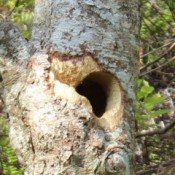
May 3, 2013 Ryukyu Shimpo
On May 2, Chosei Tamaki, the head of the Move Through Nature of Yambaru Association, an environmental non-governmental organization, submitted a formal complaint to the Nago Police Station. He said there is a possibility that construction work is adversely affecting the rearing of the young of the noguchigera, a nationally protected species of woodpecker.
Work is being carried out on the Okuni Forest Road in Hama, Kunigami using heavy machinery to create a space to deposit waste soil. He says that this has resulted in the death of chicks of the special national treasure noguchigera, or Okinawa woodpecker. This violates the Cultural Assets Preservation Act and the Act for the Conservation of Endangered Species of Wild Fauna and Flora. It is not known specifically who is responsible.
According to the complaint, the association found a noguchigera nesting hole in mid-April. The parent birds took food to the hole until April 30, but on May 2, association members found that the hole’s entrance had been damaged by some kind of knife. From that day on, the parent birds were seen occasionally looking into the hole but not taking food in.
Tamaki said, “Normally, out of consideration for the birds’ nesting, there would not be construction going on at this time of year. This construction work will be negatively affecting them.” The Okinawa Forests and Greenery Division, which manages forest roads, has not commented on the complaint because they do not yet have a clear indication of the situation.
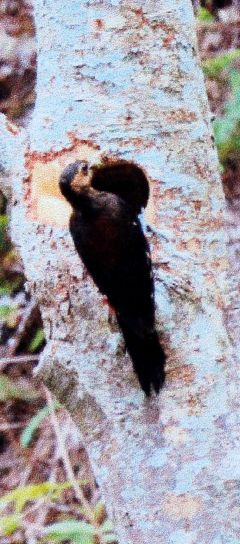
Noguchigera or Okinawa woodpecker raising their young (on April 30, the photograph was provided by Chosei Tamaki)
(English translation by T&CT, Lima Tokumori and Mark Ealey)
Go to Japanese

April 29, 2013 Ryukyu Shimpo
In order to promote sweets made with locally produced taimo, at the end of March the Kin Town Commerce and Industry Association published a booklet called “Taamu Sweets.” They printed 10,000 copies and will give them away for free. The association aims to promote taamu sweets as a resource for tourism in the same way as taco-rice. Morimitsu Kokuba, the president of the association said, “Each store makes various types of sweets using local products. We want to promote the sale of these sweets, both to tourists and locals.”

The booklet “Taamu Sweets”
A total of 18 different kinds of
taamu sweets such as baked goods and cream puffs from six stores are listed in the booklet with a description and a picture. In Kin Town, where about 300 tons of
taimo are collected yearly,
taimo sweets have been consumed for more than 20 years. In the 1990s, the association worked to establish locally produced items and from a couple of years ago, more stores have begun to sell taamu sweets. Some items are sold at the service area of Okinawa Automobile Expressway.
Taimo has become popular as sweets. Kokuba said, “Since the United States military returned the Gimbaru Training Area to Kin Town, people have greater incentive to use the land for tourism. The demand for locally produced items is now increasing because of the growth of home-stay projects. Our association wants to support stores that use local products.”
(English translation by T&CT, Megumi Chibana and Mark Ealey)
Go to Japanese
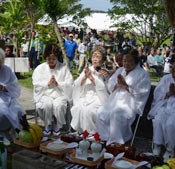
April 30, 2013 Ryukyu Shimpo
On April 28, the eleventh festival commemorating the origin of Harii dragon boat racing was held in front of the Tomise-utaki in Tomigusuku Castle Park. Tomigusuku is said to be where harii dragon boat races started. At the ritual, Tomigusuku nubui, noro and kaminchu from Tomigusuku, Nesabu, Kakazu, and Madanbashi offered sweets known as popo and amagashi to the gods and prayed for a good grain harvest and for the safety of the Naha Dragon Boat Race. A noro is a hereditary sacred woman and a kaminchu is a shaman who specializes in religious practices in Okinawa. After praying to the gods there were songs for harii and a karate performance. Many people, including members of the Naha Haryusen Association, took part in the festival.
In 1393, Wanouso, a nephew of the King of Nanzan, one of three kingdoms that controlled Okinawa in the 14th century, was impressed by dragon boat racing when he studied in Nanjing in China. After he came back from China, he made a dragon boat and showed it off on Lake Manko. People were impressed by the dragon boat and soon learned how to make it for racing.
Chairman of the Naha Haryusen (dragon boat) Promotion Association Toyoaki Kinjo said, “We made a world-class dragon boat last year. We would like to wish you all good health, long life and good luck with the race.” In the afternoon, a reenactment of the entertainment on the boat was delivered on Lake Manko, imitating the Wanouso dragon boat of 600 years ago. Many people enjoyed riding in the boat.
(English translation by T&CT, Hitomi Shinzato and Mark Ealey)
Go to Japanese
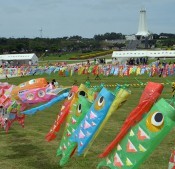
May 3, 2012 Ryukyu Shimpo
On April 27, the Okinawa Prefectural Peace Memorial Foundation held the Peace Memorial Carp Streamer Festival 2013 at the Okinawa Prefectural Peace Memorial Park in Mabuni, Itoman. The aim of the event was to let the young generation know about people’s experiences during the war 68 years ago and to provide an opportunity to think about peace.
About 15,000 carp streamers made by nursery school-age children in the local communities were put on display until May 6 in the park and among the nearby memorial monuments. Many families came out to see the streamers moving gracefully in the sky. Applause and cheers rose from the crowd when an 18-meter-long carp streamer made by Yaese resident Heizaburo Yamauchi, 65, was hoisted up.
Hatsumi Owan, 61, from Yaese, visited with her granddaughters Rino and Kano. Owan said, “When I first visited here last year, the carp streamers were so beautiful that I wanted to come back again. They are really colorful and attractive.”
(English translation by T&CT, Lima Tokumori and Mark Ealey)
Go to Japanese
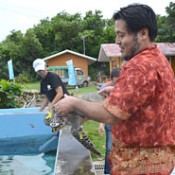
May 4, 2013 Ryukyu Shimpo
For two years, the Nagoya Public Aquarium and the Kuroshima Research Station have been carrying out a project for reintroducing hawksbill turtles into the wild. This is a project that involves breeding this variety of turtles, an endangered species, in the aquarium and then returning them to the wild. This year they have released turtles tagged with radio transmitters to track their movements.
Kuroshima has promoted the event in which tourists enjoy releasing the turtles during Golden Week.
A total of 30 turtles will be released, all of which have been raised from the eggs in the aquarium so they do not know the realities of the ocean. On April 25, the aquarium has brought 40 turtles, including ten 3-year-old animals and 20 babies under the age of one, from Nagoya to Kuroshima by airplane.
Okinawa is the northern limit of their breeding range and this species of turtle has been confirmed as currently breeding on Kuroshima. The aquarium has chosen Kuroshima for where they will release the turtles because the island is surrounded by coral reefs and is the natural habitat for the turtles. They plan to ascertain the migration path of the turtles by tracking the animals using a transmitter connected to the turtles. They released the turtles with transmitters on them two years ago, but so far have failed to collect any data. Hitoshi Okamoto, of the Nagoya Public Aquarium, said, “We have improved the method to attach the transmitter to the turtles. We carried out joint research with the United States last year, but now we must move forward under our own steam. I’m looking forward to gaining some good results.”
Motoki Wakatsuki, a staff member of the Kuroshima Institute explained, “The Institute can provide enough information as to why the turtles lay their eggs in this location because we have stored the data for many years.”
The event for releasing the turtles was held from April 27 to May 6. Tourists and locals enjoyed the contact with the animals including actually measuring the hawksbill turtles. Kazunori Nakata, a member of the Kuroshima Tourism Association, said, “I look forward to attracting tourists through an event involving the sea turtles.”
For further information, please contact to Ishigaki Dream Tourism, Phone: 0980 84 3178.
(English translation by T&CT, Mark Ealey)
Go to Japanese
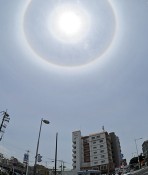
May 3, 2013 Ryukyu Shimpo
At round noon on May 2, a halo, or circle of light like a rainbow that appears around the sun, could be seen in the sky above Okinawa. Shading their eyes with their hands, people looked up at the sky to see the mysterious scene, taking pictures with the cameras in their mobile phones. This is sometimes known as a 22-degree halo of the sun.
The halo phenomenon is caused by refraction as with a prism. Sunlight hits the cirrostratus clouds, which are made up of grains of ice, as high as 10 kilometers from the ground. According to the Okinawa Meteorological Observatory this phenomenon often appears in Okinawa. On this day, the halo was clearly visible because there was very little low cloud.
Hiromi Une, a 41-year-old resident of Uruma received an email message from a friend telling her about the halo. She said, “I was really surprised at the size of the halo and enjoyed watching it with my family.”
(English translation by T&CT, Mark Ealey)
Go to Japanese

Go To Video
April 30, 2013 Ryota Shimabukuro of Ryukyu Shimpo reports from Washington D.C.
In a meeting held at the Department of Defense in the afternoon of April 29, Defense Minister Itsunori Onodera and the U.S. Secretary of Defense Chuck Hagel announced that 12 more MV-22 Osprey aircraft will be deployed to the U.S. Marine Corps Air Station Futenma this summer. The U.S. military deployed the first squadron of Osprey to the base last October. They also announced that they will carry out the relocation of Futenma Air Station to the Henoko district of Nago and the U.S. Forces Realignment Plan including moving Marines from Okinawa to Guam.
The U.S. military plans to locate the Osprey at Marine Corps Air Station Iwakuni before their deployment to Futenma Air Staion.
In the meeting, Onodera and Hagel confirmed that they will take several years to review the U.S.-Japan Defense Cooperation Guidelines that were revised in 1997. The U.S. and Japanese governments will consider how best to implement bilateral defense cooperation and clarify the allocation of roles.
With regard to the Senkaku Islands dispute, Hagel stated that while the U.S. government will not advocate a particular position it will oppose any movement to alter the status quo because Japan administers the islands and protection of this territory comes under the requirements of the Japan-U.S. Security Treaty.
(English translation by T&CT, Mark Ealey)
Go to Japanese












 Webcam(Kokusai Street)
Webcam(Kokusai Street)


